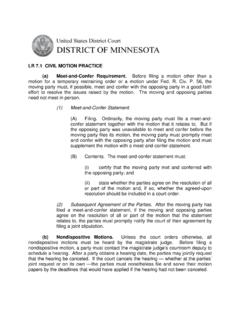Transcription of The war for talent
1 The war for talent Tell me again: Why would someone really good want to join your company? And how will you keep them for more than a few years? Yes, money does matter. ELIZABETH G. CHAMBERS, MARK FOULON, HELEN HANDFIELD-JONES, STEVEN M. HANKIN, AND EDWARD G. MICHAELS III 1998 Number 3 Better talent is worth fighting for. At senior levels of an organization, the ability to adapt, to make decisions quickly in situations of high uncertainty, and to steer through wrenching change is critical. But at a time when the need for superior talent is increasing, big US companies are finding it difficult to attract and retain good people.
2 Executives and experts point to a severe and worsening shortage of the people needed to run divisions and manage critical functions, let alone lead companies. Everyone knows organizations where key jobs go begging, business objectives languish, and compensation packages skyrocket. In an effort to understand the magnitude of this war for talent , we researched 77 large US companies in a variety of industries (see text panel). We worked with their human resources departments to understand their talent -building philosophies, practices, and challenges. And to gain a line manager perspective, we surveyed nearly 400 corporate officers and 6,000 executives from the "top 200" ranks in these companies.
3 Finally, because numbers never tell the whole story, we conducted case studies of 20 companies widely regarded as being rich in What we found should be a call to arms for corporate America. Companies are about to be engaged in a war for senior executive talent that will remain a defining characteristic of their competitive landscape for decades to come. Yet most are ill prepared, and even the best are vulnerable. You can win the war for talent , but first you must elevate talent management to a burning corporate priority. Then, to attract and retain the people you need, you must create and perpetually refine an employee value proposition: senior management's answer to why a smart, energetic, ambitious individual would want to come and work with you rather than with the team next door.
4 That done, you must turn your attention to how you are going to recruit great talent , and finally develop, develop, develop! Our survey reveals that some companies do all of these things, but many more fall short of the mark. There is a war for talent , and it will intensify Many American companies are already suffering a shortage of executive talent . Three-quarters of corporate officers surveyed said their companies had "insufficient talent sometimes" or were "chronically talent -short across the board." Not surprisingly, search firm revenues have grown twice as fast as GDP over the past five years. Part of the cause may be cyclical, the product of a strong economy at the peak of its cycle.
5 But what should keep CEOs awake at night is a number of trends that threaten a wide-ranging shortage in talent over the next five years. Until now, the executive population has grown roughly in line with GDP. This means that an economic growth rate of 2 percent for 15 years would increase demand for executives by about a third. But supply is moving in the opposite direction: the number of 35- to 44-year-olds in the United States will decline by 15 percent between 2000 and 2015 (Exhibit 1). Moreover, no significant countervailing trends are apparent. Women are no longer surging into the workforce, white-collar productivity improvements have flattened, immigration levels are stable, and executives are not prolonging their careers.
6 This would be challenge enough, but the numbers tell only half the story. Large companies also face three qualitative challenges. First, a more complex economy demands more sophisticated talent with global acumen, multi-cultural fluency, technological literacy, entrepreneurial skills, and the ability to manage increasingly delayered, disaggregated organizations. Second, the emergence of efficient capital markets in the United States has enabled the rise of many small Page 1 of 8 The McKinsey Quarterly: The Online Journal of McKinsey & medium-sized companies that are increasingly targeting the same people sought by large companies.
7 Small companies exert a powerful pull across the whole executive spectrum, offering opportunities for impact and wealth that few large firms can match. As Julian Kaufmann, director of organization development and information systems, human resources at AlliedSignal, explained, "We are competing with startups, not General Electric. We are not getting access to a whole raft of talent ." Third, and not surprisingly given the above, job mobility is increasing. Ten years ago, a high performer might have changed employers just once or twice in a full career. According to 50 senior executive search professionals we surveyed, the average executive today will work in five companies; in another 10 years, it might be seven.
8 A war once conducted as a sequence of setpiece recruiting battles is transforming itself into an endless series of skirmishes as companies find their best people, and in particular their future senior executives, under constant attack. All are vulnerable Our research suggests that executive talent has been the most undermanaged corporate asset for the past two decades. Companies that manage their physical and financial assets with rigor and sophistication have not made their people a priority in the same way. Only 23 percent of some 6,000 executives surveyed strongly agree that their companies attract highly talented people, and just 10 percent that they retain almost all their high performers.
9 Perhaps more alarmingly, only 16 percent think their companies even know who their high performers are. And only 3 percent say their companies develop people effectively and move low performers out quickly. Companies skilled at attracting, developing, and retaining talented senior executives do exist, however. Of 20 cases that we studied, seven appear to have thrived largely because of a strong performance ethic. Nine had combined strong corporate aspirations with rapid growth, as well as wealth accumulation and attractive jobs for employees (what we describe later as an attractive employee value proposition). But many of these companies had not managed talent particularly consciously until they began to see problems emerging on that front.
10 Even now, they face important talent -building challenges. Make talent management a burning priority Superior talent will be tomorrow's prime source of competitive advantage. Any company seeking to exploit it must instill a talent mindset throughout the organization, starting at the top. Leaders with a talent mindset share AlliedSignal CEO Larry Bossidy's conviction that "At the end of the day, we bet on people, not strategies." They understand why, when Jack Welch met with The Home Depot to share what is distinctive about GE's approach to managing growth, he took two human resources executives with him. They believe building their bench is a crucial part of their job.







